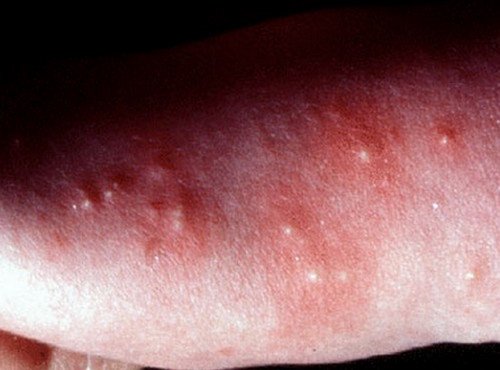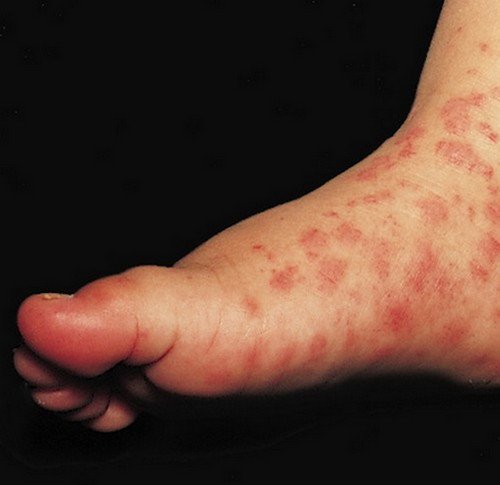Papular Urticaria
What is a popular urticaria?
It is a disorder manifested by chronic or recurrent papules (a small, raised swelling) secondary to hypersensitivity reaction.
The papule can be surrounded by a wheal. The itchy red bump is about 2 cm in diameter. In some cases, a fluid-filled blister appears. They are commonly seen in uncovered areas of the body such as the legs, forearms, and face. Urticaria is extremely itchy that you find it irresistible to scratch.
Depending on the severity, popular urticaria can become crusted and infected. Popular urticaria is not a true urticaria. The condition will usually resolve in a few hours to days. Severe cases can last for weeks. Children are more susceptible to papular urticaria than adults. (1, 2, 3)
Papular Urticaria Symptoms
- Appearance of small, raised patches of the skin, which is firm and reddish to brownish in color.
- Extremely itchy cluster of bumps that appear, disappear, and reappear in different spots of the body.
- Symmetrical distribution of lesion which is localized in a specific area (3)
Papular Urticaria Pictures

Photo 1: A patient with clinical manifestations of papular urticaria
Image Source: www.skincareguide.ca

Image 2: A severe form of papular urticaria
Picture Source: www.derm101.com
What causes papular urticaria?
A papular urticaria is commonly associated with allergic reaction to insects, especially insects that live on dogs and cats such as fleas and mites. Fleas are seen by the naked eye whereas the mites are too minute, which is somewhat difficult to notice. A papular urticaria can also be caused by allergic reaction to caterpillars, carpet beetles, and bird mites. Some forms of urticaria appear with no apparent reason at all.
A perfect example is prurigo simplex disease. What is Prurigo simplex skin disease? It is a chronic papular urticaria in adults. The cause is unknown but is believed to be a variant of atopic dermatitis. A thorough skin assessment is done to properly diagnose papular urticaria. In some instances, a skin biopsy is needed to properly diagnose papular urticaria. (4, 5, 7, 8)
Emotional stress can trigger papular urticaria. The same thing goes for people with digestive disorders. It is important to watch what you eat. Some foods have strong reaction to your skin. If you have a hypersensitive skin, it could be triggered by some food groups.
Don’t you know that genetic factors have something to do with the development of papular urticaria? Those who have a family history of papular urticaria are most likely to experience not only papular urticaria but other types as well.
Papular Urticaria Treatment
What is the best treatment for papular urticaria? What you can do to efficiently manage the condition? The treatment for papular urticaria is a combination of medical, home remedies, and preventive approach. A patient with papular urticaria suffers from extreme itching and so the primary goal is to relieve the itch.
A topical steroid cream along with antihistamine tablet help reduce itching, reduce the spots, and improve the overall condition of the patient. To reduce the infection and at the same time prevent secondary infection, an antiseptic cream is applied on the affected part. (4, 6)
When it comes to preventing papular urticaria, you need to determine the factors that cause the rash. Make sure you clean your house on a regular basis. To get rid of insects, you should spray an insecticide. If you have a carpet, make sure you regularly spray a carpet spray that contains pyrethroid.
Do not forget to vacuum the carpet regularly. As much as possible, you should keep your pet outside. If you have a hypersensitive skin, you should wear a full covering clothing so that you will have a barrier against insects. (7, 8)
What you can do at home to prevent papular urticaria?
- Identify and eradicate the cause – You should carefully examine the beddings of your pets to check for fleas and mites. If there are fleas and mites, you should apply a medicated powder not only to your pets but also in the beddings including household carpets and soft furnishing.
- Check for any bed bug infestation – If your papular urticaria has been going on for quite some time now, then you need to examine your bedding. It could be caused by a bed bug. There are over the counter products that will kill bed bugs. If it does not work, then the best thing to do is to contact your pest control firm.
- Make it a habit to wear a protective clothing, especially when going outdoor to play. The same thing goes if you are to get in contact with your pets.
- When exposed to outside environment and most of your skin is exposed, you should apply an insect repellent. (6, 9, 10)
Natural Home Remedies
Home remedies for papular urticaria are focused on the symptomatic relief. Papular urticaria can be very itchy. You should not scratch the rash because it could lead to infection, especially if you have long nails. To somehow alleviate the itch, you should apply a calamine lotion or cream.
Keep the affected area clean and dry. On the positive note, papular urticaria is self-limiting. The patient will outgrow the condition eventually. As the condition recurs, you will develop tolerance and the symptoms will eventually resolve on its own. (5, 7, 8)
Herbal remedies
- Peppermint oil – It provides fast relief for papular urticaria. It is best taken via oral route.
- Herbal teas – Tea herbs such as peppermint and parsley can help alleviate the symptoms of papular urticaria. It relieves itching and prevents infection.
- Water with turmeric powder – dissolve a turmeric powder in a lukewarm water and drink first thing in the morning. It gradually improves the symptoms of papular urticaria.
Treating papular urticaria requires a holistic approach. In other words, it should be a combination of home remedies, natural treatment, and medical approach.
The patient is strongly advised to drink a lot of water and follow a healthy diet. Exercising can also improve not just the symptoms of urticaria, but also the general condition of the body. Make it a habit to live a healthy lifestyle because it is the first line of defense against infection. (3, 6, 9)
References:
- www.dermnetnz.org
- emedicine.medscape.com
- www.healthline.com
- www.pcds.org.uk
- www.derm101.com
- www.webmd.com
- www.dermcoll.edu.au
- www.dermquest.com
- https://parentinghealthybabies.com
- www.mdedge.com